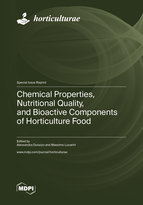Chemical Properties, Nutritional Quality, and Bioactive Components of Horticulture Food
A special issue of Horticulturae (ISSN 2311-7524). This special issue belongs to the section "Postharvest Biology, Quality, Safety, and Technology".
Deadline for manuscript submissions: closed (31 March 2023) | Viewed by 28102
Special Issue Editors
Interests: bioactive compounds; natural products; nutraceuticals; antioxidants; dietary supplements; food quality; nutrition; food composition databases; bioavailability, metabolic pathway; nanoformulations
Special Issues, Collections and Topics in MDPI journals
Interests: natural compounds; nutraceuticals; natural products; food science and nutrition; food composition databases; bioaccesibility; dietary intake
Special Issues, Collections and Topics in MDPI journals
Special Issue Information
Dear Colleagues,
Horticultural crops and products are an important source of compounds of nutritional and nutraceutical interest for human nutrition. Studies on different factors influencing the food quality of horticultural crops under different agricultural production systems are welcome. The investigation on pre- and postharvest factors under the food product quality perspective represent one of the main focuses of the Special Issue. Conventional and innovative techniques should be taken into account. New models of horticultural commodities should be analyzed, and new monitoring parameters should be proposed. Studies on classification of horticultural products are invited.
The quality of horticultural products should be explored from local and rural communities to urban ones. Studies on the use and applications of horticultural products and waste/byproducts are welcome. Attention should be given to sustainable crop production systems.
The effect of climate change on horticultural production and product quality should be taken into account.
A comprehensive image of horticultural systems and product status will be given in this Special Issue through a multidisciplinary approach that involves agronomy, chemical science, food science, and nutrition. Trends and challenges on horticultural status will be delineated and promoted. We invite you to submit to this Special Issue all type of papers, i.e., original research, reviews, and opinions.
Dr. Alessandra Durazzo
Dr. Massimo Lucarini
Guest Editors
Manuscript Submission Information
Manuscripts should be submitted online at www.mdpi.com by registering and logging in to this website. Once you are registered, click here to go to the submission form. Manuscripts can be submitted until the deadline. All submissions that pass pre-check are peer-reviewed. Accepted papers will be published continuously in the journal (as soon as accepted) and will be listed together on the special issue website. Research articles, review articles as well as short communications are invited. For planned papers, a title and short abstract (about 100 words) can be sent to the Editorial Office for announcement on this website.
Submitted manuscripts should not have been published previously, nor be under consideration for publication elsewhere (except conference proceedings papers). All manuscripts are thoroughly refereed through a single-blind peer-review process. A guide for authors and other relevant information for submission of manuscripts is available on the Instructions for Authors page. Horticulturae is an international peer-reviewed open access monthly journal published by MDPI.
Please visit the Instructions for Authors page before submitting a manuscript. The Article Processing Charge (APC) for publication in this open access journal is 2200 CHF (Swiss Francs). Submitted papers should be well formatted and use good English. Authors may use MDPI's English editing service prior to publication or during author revisions.
Keywords
- horticultural food
- chemical properties
- nutritional quality
- bioactive compounds
- applications







